
Chasing the Wind
20 April 2017
05 October 2015
12 August 2015
26 July 2015
21 July 2015
10 July 2015
03 July 2015
26 June 2015
12 June 2015
22 May 2015
19 May 2015
22 April 2015
07 April 2015
30 September 2014
17 September 2014
21 August 2014
13 August 2014
13 August 2014
13 August 2014
08 July 2014 | Douarnenez
Update from Déjà Vu
20 April 2017
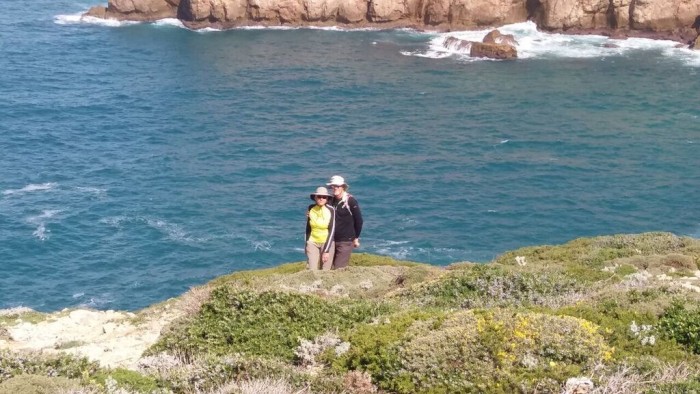
Ola from Déjà Vu
We haven’t posted anything to the blog in a long while. Mostly it’s because we’ve spent the greater portion of the last year doing the mundane things of life on land back home in the states. Blog worthy it’s not. Another reason is that we’re in the process of changing our blog host. The previous postings are still located at sailblogs.com/member/chasingthewind. Future postings will be located at: chasingthewindsite.wordpress.com.
We haven’t posted anything to the blog in a long while. Mostly it’s because we’ve spent the greater portion of the last year doing the mundane things of life on land back home in the states. Blog worthy it’s not. Another reason is that we’re in the process of changing our blog host. The previous postings are still located at sailblogs.com/member/chasingthewind. Future postings will be located at: chasingthewindsite.wordpress.com.
37 Degrees
05 October 2015
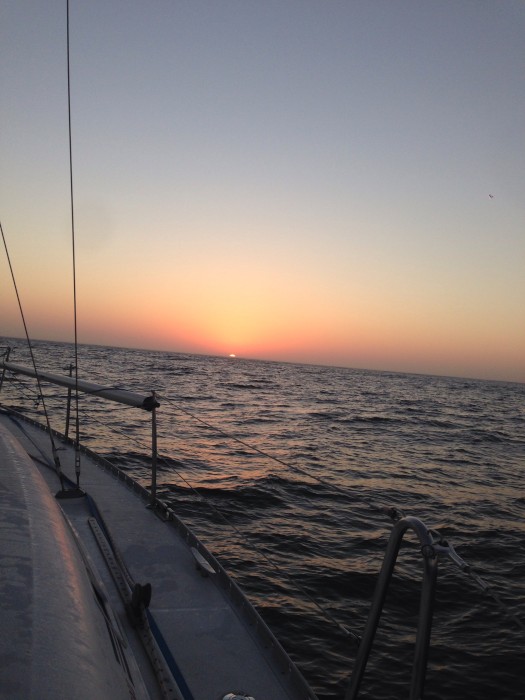
37 Degrees
No, not temperature, north latitude. The Algarve is what most people know this place as. For us, it's reminiscent of coastal California with warm sunshine, gentle breezes and thriving beachside communities. That's quite a change from the previous few weeks as we negotiated the Portuguese west coast. Here is a short recap:
For most of our time in the Spanish rias, the biggest challenge was where to drop the hook. As there were often several great anchoring spots to choose from, our choice often came down to which one have we not been to yet. Some were close to the big city, most were near a small village or community and a few were off a rugged island with a tiny beach for a landing. Many were protected from the prevailing weather. The wash from the many local ferries, however, frequently discounted an otherwise superb spot. If it sounds like we thoroughly enjoyed our time there, you're right. We could have easily spent the remainder of the season visiting the spots we missed. Somewhere during this time we committed to wintering in Lagos, Portugal. Several boats we met in the Rias were headed there and all had high praise of the place. A quick glance at the chart told me all I needed to know - Lagos is at 37 Degrees north latitude. Aahh, California-style weather!
Unfortunately, the west coast of Portugal has a well-deserved reputation as a challenging place to sail. For starters, anchorages are very scarce. More importantly, the west coast bears the full brunt of the Atlantic and you feel that right out of the gate with the persistent swell. It turns out the swell dictated our plans more than any single factor. Many west coast ports would close if the swell was over 2 meters (6 feet). We ended up motoring or motor sailing much of the west coast due to swell. If the wind picked-up to nice sailing velocity, often it meant a large swell was present also. If you chose low swell, generally the wind was light. A dilemma that drove us nuts! The other defining feature along this coast is the profusion of crab pots. They started immediately upon entering Portuguese waters and, at times, were so thick it felt like we were negotiating a mine field. Most were well marked with a single flag on a stick about a meter tall. Some were just a float, often of a similar color to the sea. Surprisingly, the pots were especially thick around the entrances to ports. Watch-keeping became an exercise of constant vigilance. We soon ignored any pots that were not in our direct path. After six hours of sailing we would arrive at the next port just knackered from keeping watch. Go into deeper water you say? Yea, we tried that too; we found them in 90 meters and five miles offshore! Entering or leaving ports at night became risky and we made every effort to avoid this - to the point of making a much safer overnight passage far offshore ... In compensation for the often frustrating sailing, the pleasant towns we stopped at along the way were a real treat. Like Viana do Castelo, our introduction to Portugal and Porto, which hopefully needs no introduction. Or Nazare, home of the largest recorded wave in Europe and the largest ever wave surfed (by an American I am happy to say).
So, it was after a long, windless night motoring from Lisbon and around Cabo Sao Vincente, that we arrived in Alvor with a dolphin accompaniment at sunrise. There couldn't have been more of a contrast from the big city to this small estuary on the Algarve coast. The Rio Alvor reminds me of a scaled-down Petaluma River with its birds and marsh habitat. It's a bit tricky to enter as the channel is shallow, narrow and with buoyage that hasn't changed with the shifting bottom. Luckily, we had our English friends reconnoiter the entrance a week earlier, so their knowledge was invaluable as we negotiated the twists and turns. Once inside, you're greeted to a pretty town spread out over a low hill and a fair size anchorage mostly filled with derelict boats on moorings. The real value of this place is its proximity to Lagos and Portimao as it provides a "waiting room" for the many boats (including us) who's winter contracts don't start until October 1. But it's the serenity of the place we're loving right now.
No, not temperature, north latitude. The Algarve is what most people know this place as. For us, it's reminiscent of coastal California with warm sunshine, gentle breezes and thriving beachside communities. That's quite a change from the previous few weeks as we negotiated the Portuguese west coast. Here is a short recap:
For most of our time in the Spanish rias, the biggest challenge was where to drop the hook. As there were often several great anchoring spots to choose from, our choice often came down to which one have we not been to yet. Some were close to the big city, most were near a small village or community and a few were off a rugged island with a tiny beach for a landing. Many were protected from the prevailing weather. The wash from the many local ferries, however, frequently discounted an otherwise superb spot. If it sounds like we thoroughly enjoyed our time there, you're right. We could have easily spent the remainder of the season visiting the spots we missed. Somewhere during this time we committed to wintering in Lagos, Portugal. Several boats we met in the Rias were headed there and all had high praise of the place. A quick glance at the chart told me all I needed to know - Lagos is at 37 Degrees north latitude. Aahh, California-style weather!
Unfortunately, the west coast of Portugal has a well-deserved reputation as a challenging place to sail. For starters, anchorages are very scarce. More importantly, the west coast bears the full brunt of the Atlantic and you feel that right out of the gate with the persistent swell. It turns out the swell dictated our plans more than any single factor. Many west coast ports would close if the swell was over 2 meters (6 feet). We ended up motoring or motor sailing much of the west coast due to swell. If the wind picked-up to nice sailing velocity, often it meant a large swell was present also. If you chose low swell, generally the wind was light. A dilemma that drove us nuts! The other defining feature along this coast is the profusion of crab pots. They started immediately upon entering Portuguese waters and, at times, were so thick it felt like we were negotiating a mine field. Most were well marked with a single flag on a stick about a meter tall. Some were just a float, often of a similar color to the sea. Surprisingly, the pots were especially thick around the entrances to ports. Watch-keeping became an exercise of constant vigilance. We soon ignored any pots that were not in our direct path. After six hours of sailing we would arrive at the next port just knackered from keeping watch. Go into deeper water you say? Yea, we tried that too; we found them in 90 meters and five miles offshore! Entering or leaving ports at night became risky and we made every effort to avoid this - to the point of making a much safer overnight passage far offshore ... In compensation for the often frustrating sailing, the pleasant towns we stopped at along the way were a real treat. Like Viana do Castelo, our introduction to Portugal and Porto, which hopefully needs no introduction. Or Nazare, home of the largest recorded wave in Europe and the largest ever wave surfed (by an American I am happy to say).
So, it was after a long, windless night motoring from Lisbon and around Cabo Sao Vincente, that we arrived in Alvor with a dolphin accompaniment at sunrise. There couldn't have been more of a contrast from the big city to this small estuary on the Algarve coast. The Rio Alvor reminds me of a scaled-down Petaluma River with its birds and marsh habitat. It's a bit tricky to enter as the channel is shallow, narrow and with buoyage that hasn't changed with the shifting bottom. Luckily, we had our English friends reconnoiter the entrance a week earlier, so their knowledge was invaluable as we negotiated the twists and turns. Once inside, you're greeted to a pretty town spread out over a low hill and a fair size anchorage mostly filled with derelict boats on moorings. The real value of this place is its proximity to Lagos and Portimao as it provides a "waiting room" for the many boats (including us) who's winter contracts don't start until October 1. But it's the serenity of the place we're loving right now.
Nobody parties like the Spanish
12 August 2015
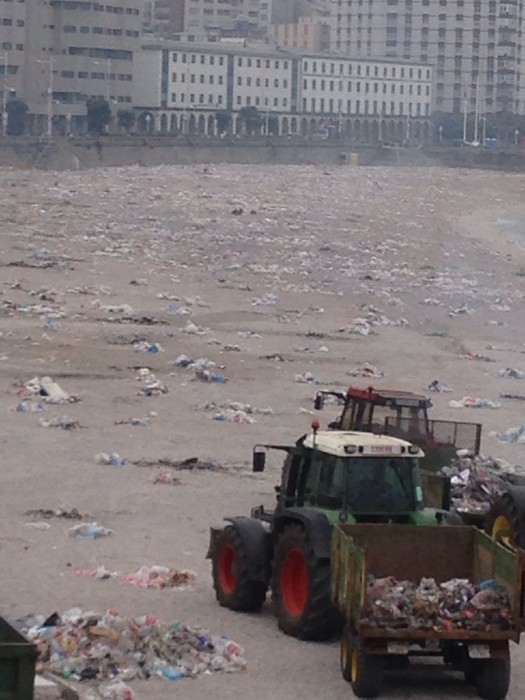
Fiesta is a way of life here. It occurs often and with much vigor & passion. Weekly, something is happening that is worthy of fiesta. It might be the local wine that is celebrated or perhaps an ancient religious figure. For whatever reason, the fiesta is invariably a multi-day (sometimes a multi-week!) affair that starts on a Friday and builds to a crescendo on Sunday. We first encountered fiesta in tiny Ribadesella with the celebration of Corpus Christi, a religious holiday 7 weeks in the making. While there one evening around 9 PM we heard, and felt, a large explosion going off next to the boat. It so pierced the evening calm that I was sure that something had collided with great force very nearby. Then another explosion seconds later, and a third and ... By this time I'm in the cockpit wondering what the f... is going on!!! Of course, it was the start of fiesta! And to let everyone know, the Spanish light off large, professional-grade bottle rockets. From the opposite bank of the small river, we were much closer to the explosion than the townspeople. The fireworks continued well into the evenings right through to the night before we left.
When in la Coruna, we had heard from locals that a major fiesta was culminating in town the following evening and the marina as well as most shops would closed. By now we understood the fiesta thing and just accepted the fact that most services would be unavailable. While out walking the town that day, the shops were indeed closed. However, I saw lots of people out and about, including many youth apparently collecting old furniture and what appeared to me as garbage. I dismissed it as nothing noteworthy and moved on. Later the same day, Pam was walking along the promenade and noticed lines of vehicles unloading broken-up furniture and other "garbage" to the beautiful, mile-long crescent shaped beach. She apparently dismissed it as nothing noteworthy as well. That evening we commented on the smoky haze in the air but lamely didn't make any connection to the day's events.
Pam returned to the promenade the following morning and was greeted by a mile-long sea of smouldering garbage where the beach used to be. An army of clean-up workers were busily piling the garbage into large mounds to be picked up with a fleet of tractors, loaded onto trailers and hauled away. The large scale of the operation matched the size of the beach. By late afternoon the garbage was hauled away and the beach was as clean and smooth as a newly groomed ski run. Later, we asked a local guy why the beach was trashed and his response was that it is a tradition; it's always been that way. He acknowledged that it is an eyesore and poor for the environment. He also commented that the younger generation is more aware of the issue and has led a movement to have large dumpster bins placed on the beach to encourage fiesta goers to clean-up after themselves. From our vantage, it appeared that very few people cleaned up anything. We also learned the fiesta was the culmination of the religious holiday Corpus Christi that we first experienced in Ribadesella several weeks earlier!
Sent from my iPad
When in la Coruna, we had heard from locals that a major fiesta was culminating in town the following evening and the marina as well as most shops would closed. By now we understood the fiesta thing and just accepted the fact that most services would be unavailable. While out walking the town that day, the shops were indeed closed. However, I saw lots of people out and about, including many youth apparently collecting old furniture and what appeared to me as garbage. I dismissed it as nothing noteworthy and moved on. Later the same day, Pam was walking along the promenade and noticed lines of vehicles unloading broken-up furniture and other "garbage" to the beautiful, mile-long crescent shaped beach. She apparently dismissed it as nothing noteworthy as well. That evening we commented on the smoky haze in the air but lamely didn't make any connection to the day's events.
Pam returned to the promenade the following morning and was greeted by a mile-long sea of smouldering garbage where the beach used to be. An army of clean-up workers were busily piling the garbage into large mounds to be picked up with a fleet of tractors, loaded onto trailers and hauled away. The large scale of the operation matched the size of the beach. By late afternoon the garbage was hauled away and the beach was as clean and smooth as a newly groomed ski run. Later, we asked a local guy why the beach was trashed and his response was that it is a tradition; it's always been that way. He acknowledged that it is an eyesore and poor for the environment. He also commented that the younger generation is more aware of the issue and has led a movement to have large dumpster bins placed on the beach to encourage fiesta goers to clean-up after themselves. From our vantage, it appeared that very few people cleaned up anything. We also learned the fiesta was the culmination of the religious holiday Corpus Christi that we first experienced in Ribadesella several weeks earlier!
Sent from my iPad
Ria Vigo
26 July 2015
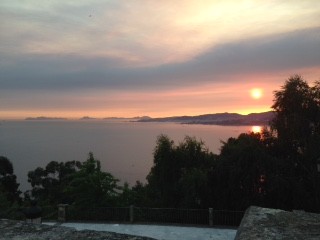
The southernmost of the Rias Baixas, this Ria is very industrial on the south shore as Vigo is a major port and city in this part of the country. The north shore is quieter and has small villages, and a more relaxed pace. It's also home to the largest nudist beach in these parts, Ensenada de Barra. When we sailed by, there were lots of boats anchored just off the beach - Ostensibly for protection from the wind...
We continued sailing about as far into the Ria as possible and anchored near the haunted island of San Simón. Apparently during Spain's dark years of the Spanish civil war, the island was used as a concentration camp for extermination of political prisoners opposed to the ruler Franco. Not wanting to incur the wrath of any bad juju, we toured the island from afar and landed on the beach near the small village of Cesantes. The village hugs the adjacent hillside, but it was not clear how to get there as there were fences, rough brambles and rather run-down homes all along the waterfront. I went to scout out a path as Pam wisely stayed with the dinghy; she wasn't interested in the possibility of bushwhacking. After searching for a path up to the village for maybe 1/8 mile, I came across a señora hanging clothes on a line. I asked her with my best Spanglish if she could tell me where the supermercado is located. She launched into such a rapid-fire Spanish response, I had no chance in understanding. With each exchange of her Spanish and my Spanglish, we seemed to get further from any resemblance of comprehension. After a while, we both realized this and then she went to get a lady neighbor who, I assumed, would be able to help. The neighbor arrived and was indeed multilingual, only in German and Spanish! So the neighbor now takes up the challenge of communicating with the gringo as the señora disappears into her home, likely not interested in wasting any more of her time. After perhaps 10 minutes of woefully inadequate Spanglish, hand gestures and funny faces on my part, the señora appears from her home with a grocery bag and offers it to me. Inside there is a sandwich, a couple of pieces of fruit and a bottle of water! With my mind racing to decline the very generous offer, but also aware that in doing so would be considered extremely rude, I grudgingly accepted and profusely thanked her. We parted with me not understanding any better how to get to the village, but with her simple act of kindness, words were unnecessary in communicating. Later, when I returned to the dinghy, Pam commented that it was likely that the ladies mistook me for a pilgrim and figured I needed nourishment for the remainder of the trek to Santiago. Come to think of it, I was looking a bit scruffy with a three day beard and no shower that day ...
After exploring Ensenada de San Simōn and the upper reaches of the Ria, we did anchor just off the nudist beach. The following day (a Saturday) we went for a hike and paddled the dinghy over in the morning. There weren't many people on the beach at that time, but when we came back it was wall-to-wall people and we were definitely over dressed! The anchorage was also transformed from perhaps 7 or 8 boats to over 50. Wow, it was really a shocker to see! We had just hiked over 10 gorgeous miles along the coastline between Rias Pontevedra and Vigo, visiting two lighthouses and an ancient, Iron Age stone village Monte Facho. We were tired, it was blazingly hot with little breeze and we both felt like stripping off and joining them right there (when in Rome ....). But Pam and I had a plan as the dinghy was all the way up the beach and we had to negotiate the brown-as-a-nut all over masses to get it to the water. We strode confidently, fully clothed, behind most of the beach goers and when we reached the dinghy, we lifted it with our best form, mindful that it weighs a ton and it's never graceful to move anywhere. As it turned out, it was quite pleasant as the masses parted enough for us to get through to the water and we thanked them with a hearty "Gracias!" just like normal folk ...
The perfect anchorage (sort of)
21 July 2015
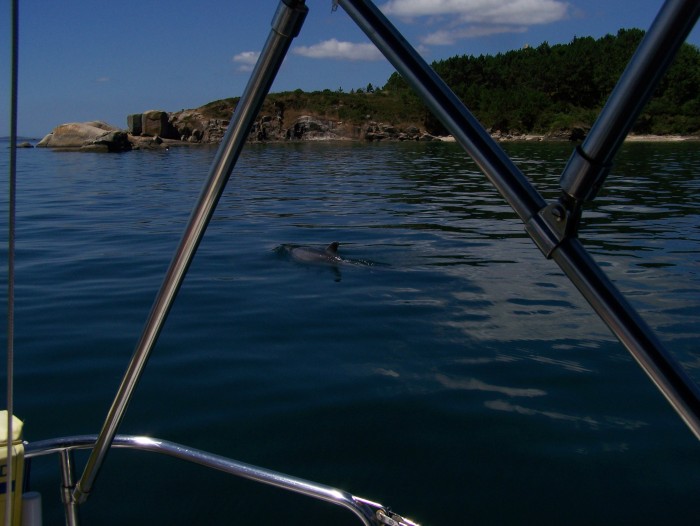
It was a Saturday morning and we arrived at a beautiful anchorage in Ria Arousa the afternoon before. The anchorage is fairly compact just off a pretty beach and surrounded by large, smooth boulders and a few isolated rocks closer to shore lurking just below the water surface. We were the only boat there. I commented to Pam that I wondered why there aren't more boats here - it was just so pretty. Romantic were her words ... The forecast was for afternoon winds of 15 - 20 knots out of the North west, in which we would be fairly well protected. The morning dawned bright and calm - zero wind. We lazed aboard Déjà Vu and contemplated putting the dinghy together, but decided a nap sounded more appropriate. At lunch (noonish) we were still the only boat. As if someone turned a tap, when the clock hit 1400, powerboats large and small descended on our little slice of nirvana. It's funny, but power boaters seem to want to get just inches from the beach. In true fashion, all of them blaze past us and proceed to drop a pile of chain on the bottom, turn off the motor and then crack the first beer. Pam counted 14 boats between us and the beach! I was ok as they were still quite far from us until a couple in an older, mid-size sailboat pulled up literally 30 feet to the north of us and proceeded to drop a pile of chain. They weren't interested in beer however. Typically macho, he was accompanied by a topless female companion in a string bikini. Each felt the need for a quick dip off the back of the boat and, quite obviously, a more intimate liaison down below. With my worst case scenario of a sailboat dragging down on us playing out, I was uncomfortable and concerned, but not alarmed - yet. The afternoon was filled with loud Spanish families enjoying the water, jet skis zipping about and, thankfully, no detectable sound from the boat parked on top of us. At its peak, We counted 17 boats surrounding us in this formerly peaceful anchorage! We surmised all would likely go back to where they came from by nightfall and we'll have a peaceful anchorage once again. Well, we had a little help from Mother Nature in the form of a north easterly that picked-up from nothing to 20 knots in the space of about 10 minutes. With the wind from that direction, everyone was uncomfortable, including us. Fortunately, Our closest neighbors had left earlier and, as quickly as they came, the power boaters left en masse. We ended up leaving as well as I felt the holding was not good and the rocks, now the lee shore, seemed bigger. So we really aren't true pioneers discovering a virgin anchorage; it's just the Spanish have yet to wake up from siesta!
Santiago de Compostela
10 July 2015
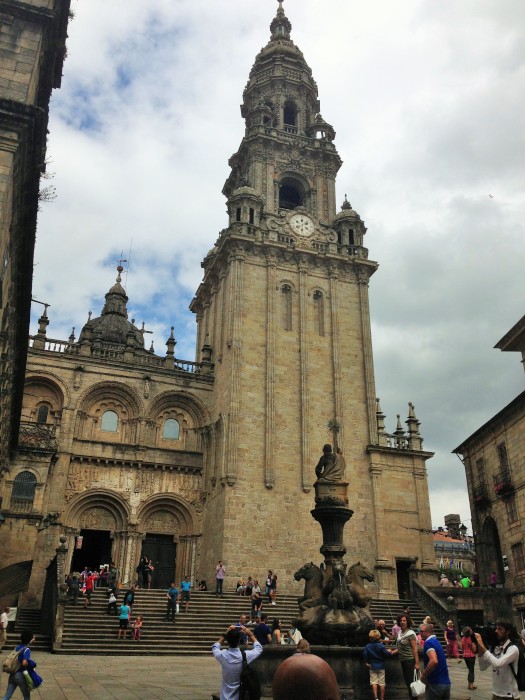
Our brief chats with the American pilgrims in Ribadesella just whetted our appetite even more to visit their (and countless others) sacred destination. We got our chance when visiting the most northerly of the large Rias Baixas - Ria de Muros y Noia. Santiago de Compostela, or simply Santiago, is a 45 minute bus ride from the marina in Portosin, the closest port Déjà Vu could access. The object of all the interest is the holy remains of St. James the Apostle buried beneath the church. By the 11th century, the pilgrimage along the Camino de Santiago was well established. In time, a city built up around the church and today Santiago is home to about 80,000 people. But it's the old church we came to see - us and scores of tourists and pilgrims alike that day.
Tourism is a major industry in Santiago, but it's the seductively festive atmosphere when nearing the church that draws you in. The day we were there a group of perhaps 50 high school age kids celebrated their arrival en masse with loud chants, lots of high-fives and hugs of relief and joy. In addition, we saw many family groups of parents and teen age kids along with literally hundreds of other Trekkers arriving from far and wide along the Camino. Some looked trail weary and a bit scruffy, others seemed as if they were out for a little jaunt around the block. Almost universally, they each had a sea shell hanging from their backpack - the symbol of the Camino de Santiago. The mood around the large plaza do Obradoiro at the foot of the steps to the church was a heady mixture of quiet achievement, obvious fatigue and fun. Many of the pilgrims chose to kneel and pray right there; afterwards falling to a heap next to their pack on the cobbles. You can't help but feel at least some of their accomplishment.
The magnificent old church certainly grabs your attention with its soaring archways, elaborate porticos and a massive Botafumero (smoke spitter or incense burner) hanging from the ceiling at the centre of the cathedral. We were told theBotafumero is used only on certain religious holidays or, if have the cash, €300 will get the bishops to give it a whirl in your honor. Capitalism, don't you love it! Even if you have no religious inclination, the level of detail in the construction of the church is mind boggling. Most of the artwork on the walls and ceilings is not paint, but small chips of different colored stone arranged to create what the artist envisioned. There had to be thousands of colored stone chips in just one such rendition. Inside, the Portico de la Gloria dominates with its large and very lifelike sculptures. Of note is the figure of Queen Esther who, apparently was more well endowed before a disapproving bishop felt her breasts should be smaller. The locals thought Esther's figure was just fine, so in protest they created the cone-shape Tetilla (nipple) cheese seen everywhere in the stores. Being the curious tourists we are, we had to try this most unusual of cheeses. I have to report that it was soft with a creamy texture ...
| Vessel Name: | Deja Vu |
| Vessel Make/Model: | Beneteau Oceanis 361 |
| Hailing Port: | San Francisco, CA USA |
| Crew: | Pam and Roger |
| About: |
Gallery not available
Livin' the dream
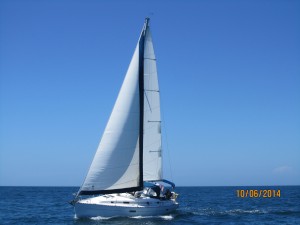
Who: Pam and Roger
Port: San Francisco, CA USA